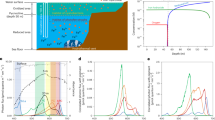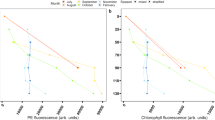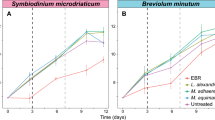Abstract
The tropical ascidian Lissoclinum patella hosts two enigmatic cyanobacteria: (1) the photoendosymbiont Prochloron spp., a producer of valuable bioactive compounds and (2) the chlorophyll-d containing Acaryochloris spp., residing in the near-infrared enriched underside of the animal. Despite numerous efforts, Prochloron remains uncultivable, restricting the investigation of its biochemical potential to cultivation-independent techniques. Likewise, in both cyanobacteria, universally important parameters on light-niche adaptation and in situ photosynthetic regulation are unknown. Here we used genome sequencing, transcriptomics and metabolomics to investigate the symbiotic linkage between host and photoendosymbiont and simultaneously probed the transcriptional response of Acaryochloris in situ. During high light, both cyanobacteria downregulate CO2 fixing pathways, likely a result of O2 photorespiration on the functioning of RuBisCO, and employ a variety of stress-quenching mechanisms, even under less stressful far-red light (Acaryochloris). Metabolomics reveals a distinct biochemical modulation between Prochloron and L. patella, including noon/midnight-dependent signatures of amino acids, nitrogenous waste products and primary photosynthates. Surprisingly, Prochloron constitutively expressed genes coding for patellamides, that is, cyclic peptides of great pharmaceutical value, with yet unknown ecological significance. Together these findings shed further light on far-red-driven photosynthesis in natural consortia, the interplay of Prochloron and its ascidian partner in a model chordate photosymbiosis and the uncultivability of Prochloron.
Similar content being viewed by others
Log in or create a free account to read this content
Gain free access to this article, as well as selected content from this journal and more on nature.com
or
References
Addlesee HA, Gibson LCD, Jensen PE, Hunter CN . (1996). Cloning, sequencing and functional assignment of the chlorophyll biosynthesis gene, chZP, of Synechocystis sp. PCC 6803. FEBS Lett 389: 2–6.
Alam J, Whitaker RA, Krogmann DW, Curtis SE . (1986). Isolation and sequence of the gene for ferredoxin I from the cyanobacterium Anabaena sp. strain PCC 7120. J Bacteriol 168: 1265–1271.
Albertsen M, Hugenholtz P, Skarshewski A, Nielsen KL, Tyson GW, Nielsen PH . (2013). Genome sequences of rare, uncultured bacteria obtained by differential coverage binning of multiple metagenomes. Nat Biotechnol 31: 533–538.
Aziz R, Bartels D, Best A, DeJongh M, Disz T, Edwards R et al. (2008). The RAST Server: rapid annotations using subsystems technology. BMC Genomics 9: 1–15.
Badger MR, Price GD . (1994). The role of carbonic anhydrase in photosynthesis. Annu Rev Plant Physiol Plant Mol Biol 45: 369–392.
Bailey S, Silva P, Nixon P, Mullineaux C, Robinson C, Mann N . (2001). Auxiliary functions in photosynthesis: the role of the FtsH protease. Biochem Soc Trans 29: 455–459.
Baptista MS, Vasconcelos MT . (2006). Cyanobacteria metal interactions: requirements, toxicity, and ecological implications. Crit Rev Microbiol 32: 127–137.
Behrendt L, Larkum A, Trampe E, Norman A, Sørensen S, Kühl M . (2012). Microbial diversity of biofilm communities in microniches associated with the didemnid ascidian Lissoclinum patella. ISME J 6: 1222–1237.
Behrendt L, Staal M, Cristescu SM, Harren FJ, Schliep M, Larkum AW et al. (2013). Reactive oxygen production induced by near-infrared radiation in three strains of the Chl d-containing cyanobacterium Acaryochloris marina. F1000Res 2: 1–12.
Bertram A, Pattenden G . (2007). Marine metabolites: metal binding and metal complexes of azole-based cyclic peptides of marine origin. Nat Prod Rep 24: 18–30.
Boughton BA, Callahan DL, Silva C, Bowne J, Nahid A, Rupasinghe T et al. (2011). Comprehensive profiling and quantitation of amine group containing metabolites. Anal Chem 83: 7523–7530.
Calloni G, Chen T, Schermann SM, Chang HC, Genevaux P, Agostini F et al. (2012). DnaK functions as a central hub in the E. coli chaperone network. Cell Rep 1: 251–264.
Charpentier E, Novak R, Tuomanen E . (2000). Regulation of growth inhibition at high temperature, autolysis, transformation and adherence in Streptococcus pneumoniae by ClpC. Mol Microbiol 37: 717–726.
Comba P, Eisenschmidt A . (2017), Structures, electronics and reactivity of copper(II) complexes of the cyclic pseudo-peptides of the ascidians. In: Hanson G, Berliner L (eds). Future Directions in Metalloprotein and Metalloenzyme Research. Springer International Publishing: Cham, pp 13–32.
Comba P, Eisenschmidt A, Gahan LR, Herten D-P, Nette G, Schenk G et al. (2017). Is Cu II coordinated to patellamides inside Prochloron cells? Chem—A Eur J 23: 12264–12274.
Comba P, Eisenschmidt A, Kipper N, Schießl J . (2016). Glycosidase- and β-lactamase-like activity of dinuclear copper(II) patellamide complexes. J Inorg Biochem 159: 70–75.
Comba P, Gahan LR, Hanson GR, Maeder M, Westphal M . (2013). Carbonic anhydrase activity of dinuclear Cu(II) complexes with patellamide model ligands. Dalt Trans 43: 3144–3152.
Comba P, Gahan LR, Hanson GR, Westphal M . (2012). Phosphatase reactivity of a dicopper(ii) complex of a patellamide derivative—possible biological functions of cyclic pseudopeptides. Chem Commun 48: 9364.
Dehal P, Satou Y, Campbell RK, Chapman J, Degnan B, De Tomaso A et al. (2002). The draft genome of Ciona intestinalis : insights into chordate and vertebrate origins. Science 298: 2157–2167.
Dias DA, Hill CB, Jayasinghe NS, Atieno J, Sutton T, Roessner U . (2015). Quantitative profiling of polar primary metabolites of two chickpea cultivars with contrasting responses to salinity. J Chromatogr B 1000: 1–13.
Dietz K-J . (2011). Peroxiredoxins in plants and cyanobacteria. Antioxid Redox Signal 15: 1129–1159.
Donia MS, Fricke WF, Partensky F, Cox J, Elshahawi SI, White JR et al. (2011). Complex microbiome underlying secondary and primary metabolism in the tunicate-Prochloron symbiosis. Proc Natl Acad Sci USA 108: 1423–1432.
Dunlap WC, Yamamoto Y . (1995). Small-molecule antioxidants in marine organisms: antioxidant activity of mycosporine-glycine. Comp Biochem Physiol Part B Biochem Mol Biol 112: 105–114.
Eisenhut M . (2006). The plant-Like C2 glycolate cycle and the bacterial-like glycerate pathway cooperate in phosphoglycolate metabolism in cyanobacteria. Plant Physiol 142: 333–342.
Eisenhut M, Ruth W, Haimovich M, Bauwe H, Kaplan A, Hagemann M . (2008). The photorespiratory glycolate metabolism is essential for cyanobacteria and might have been conveyed endosymbiontically to plants. Proc Natl Acad Sci USA 105: 17199–17204.
Emlyn-Jones D, Woodger FJ, Price GD, Whitney SM . (2006). RbcX can function as a rubisco chaperonin, but is non-essential in Synechococcus PCC7942. Plant Cell Physiol 47: 1630–1640.
Eriksson M-J, Clarke AK . (1996). The heat shock protein ClpB mediates the development of thermotolerance in the Cyanobacterium Synechococcus sp. Strain PCC 7942. J Bacteriol 178: 4839–4846.
Fisher CRJ, Trench RK . (1980). In vitro carbon fixation by Prochloron sp. isolated from Diplosoma virens. Biol Bull 159: 636–648.
Gao Q, Garcia-pichel F . (2011a). Microbial ultraviolet sunscreens. Nat Rev Microbiol 9: 791–802.
Gao Q, Garcia-Pichel F . (2011b). An ATP-grasp ligase involved in the last biosynthetic step of the iminomycosporine shinorine in Nostoc punctiforme ATCC 29133. J Bacteriol 193: 5923–5928.
Griffiths D, Thinh L . (1983). Transfer of photosynthetically fixed carbon between the prokaryotic green alga Prochloron and its ascidian host. Aust J Mar Freshw Res 34: 431–440.
Haimovich-Dayan M, Lieman-Hurwitz J, Orf I, Hagemann M, Kaplan A . (2015). Does 2-phosphoglycolate serve as an internal signal molecule of inorganic carbon deprivation in the cyanobacterium Synechocystis sp. PCC 6803? Environ Microbiol 17: 1794–1804.
Hattori M, Iwase N, Furuya N, Tanaka Y, Tsukazaki T, Ishitani R et al. (2009). Mg2+-dependent gating of bacterial MgtE channel underlies Mg2+ homeostasis. EMBO J 28: 3602–3612.
Herman H, Shambaugh E . (1977). Urea biosynthesis I. The urea cycle and relationships acid cycle. Am J Clin Nutr 30: 2083–2087.
Hervas M, Navarro F, Navarro JA, Chavez S, Diaz A, Florencio FJ et al. (1993). Synechocystis 6803 plastocyanin isolated from both the cyanobacterium and E. coli transformed cells are identical. FEBS Lett 319: 257–260.
Hirose E, Neilan B, Schmidt E, Murakami A . (2009), Enigmatic life and evolution of Prochloron and related cyanobacteria inhabiting colonial ascidians. In: Gault PM, Marler HJ (eds). Handbook on cyanobacteria: biochemistry, biotechnology and applications. Nova Science Publishers: Hauppauge, NY, USA, pp 161–189.
Horváth I, Multhoff G, Sonnleitner A, Vígh L . (2008). Membrane-associated stress proteins: more than simply chaperones. Biochim Biophys Acta 1778: 1653–1664.
Huang L, McCluskey MP . (2002). Global gene expression profiles of the cyanobacterium Synechocystis sp. strain PCC 6803 in response to irradiation with UV-B and white light. J Bacteriol 184: 6845.
Jensen PE, Gibson LCD, Henningsen KW, Hunter CN . (1996). Expression of the chlI chlD, and chlH genes from the Cyanobacterium Synechocystis PCC6803 in Escherichia coli and demonstration that the three cognate proteins are required for magnesium-protoporphyrin chelatase activity. J Biol Chem 271: 16662–16667.
Jensen SI, Steunou A-S, Bhaya D, Kühl M, Grossman AR . (2011). In situ dynamics of O2, pH and cyanobacterial transcripts associated with CCM, photosynthesis and detoxification of ROS. ISME J 5: 317–328.
Johnson CH, Stewart PL, Egli M . (2011). The cyanobacterial circadian system: from biophysics to bioevolution. Annu Rev Biophys 40: 143–167.
Kerfeld CA, Sawaya MR, Tanaka S, Nguyen CV, Phillips M, Beeby M et al. (2005). Protein structures forming the shell of primitive bacterial organelles. Science 309: 936–938.
Kilian O, Steunou AS, Grossman AR, Bhaya D . (2008). A novel two domain-fusion protein in cyanobacteria with similarity to the CAB/ELIP/HLIP superfamily: evolutionary implications and regulation. Mol Plant 1: 155–166.
Kim Y-I, Vinyard DJ, Ananyev GM, Dismukes GC, Golden SS . (2012). Oxidized quinones signal onset of darkness directly to the cyanobacterial circadian oscillator. Proc Natl Acad Sci USA 109: 17765–17769.
Kline TJ, Lewin R . (1999). Natural 15N/14N abundance as evidence for N2 fixation by Prochloron (Prochlorophyta) endosymbiotic with didemnid ascidians. Symbiosis 26: 193–198.
Kopylova E, Noe L . (2012). Sequence analysis SortMeRNA : fast and accurate filtering of ribosomal RNAs in metatranscriptomic data. Bioinformatics 28: 3211–3217.
Kremer B, Pardy R, Lewin R . (1982). Carbon fixation and photosynthates of Prochloron, a green alga symbiotic with an ascidian, Lissoclinum patella. Phycologia 21: 258–263.
Krupp E, Wright SH, Raab A . (2012), Marine metabolites and metal ion chelation. In: Fattorusso E, Gerwick WH, Taglialatela-Scafati O (eds). Handbook of Marine Natural Products. Springer Netherlands: Dordrecht, pp 861–892.
Kühl M, Behrendt L, Trampe E, Qvortrup K, Schreiber U, Borisov SM et al. (2012). Microenvironmental ecology of the chlorophyll b-containing symbiotic Cyanobacterium Prochloron in the didemnid ascidian Lissoclinum patella. Front Microbiol 3: 402.
Kühl M, Chen M, Ralph P, Schreiber U, Larkum AWD . (2005). A niche for cyanobacteria containing chlorophyll d. Nature 433: 820.
Lehel C, Wada H, Kovács E, Török Z, Gombos Z, Horváth I et al. (1992). Heat shock protein synthesis of the cyanobacterium Synechocystis PCC 6803: purification of the GroEL-related chaperonin. Plant Mol Biol 18: 327–336.
Lesser MP, Stochaj WR . (1990). Photoadaptation and protection against active forms of oxygen in the symbiotic procaryote Prochloron sp. and its ascidian host. Appl Environ Microbiol 56: 1530–1535.
Lewin R, Withers N . (1975). Extraordinary pigment composition of a prokaryotic alga. Nature 256: 735–737.
Liu Y, Tsinoremas NF, Johnson CH, Lebedeva NV, Golden SS, Ishiura M et al. (1995). Circadian orchestration of gene expression in cyanobacteria. Genes Dev 9: 1469–1478.
Long PF, Dunlap WC, Battershill CN, Jaspars M . (2005). Shotgun cloning and heterologous expression of the patellamide gene cluster as a strategy to achieving sustained metabolite production. Chembiochem 6: 1760–1765.
López-Legentil S, Song B, Bosch M, Pawlik J, Turon X . (2011). Cyanobacterial diversity and a new Acaryochloris-like symbiont from Bahamian sea-squirts. PLoS One 6: e23938.
Makarova KS . (2011). Evolution and classification of the CRISPR–Cas systems. Nat Rev Microbiol 9: 467–477.
Malo MS, Loughlin RE . (1990). Promoter elements and regulation of expression of the cysD gene of Escherichia coli K-12. Gene 87: 127–131.
Markus JA, Lambert CC . (1983). Urea and ammonia excretion by solitary ascidians. J Exp Mar Bio Ecol 66: 1–10.
Maruyama T, Hirose E, Ishikura M . (2003). Ultraviolet-light-absorbing tunic cells in didemnid ascidians hosting a symbiotic photo-oxygenic prokaryote. Prochloron Biol Bull 204: 109–113.
Maurino VG, Peterhansel C . (2010). Photorespiration: current status and approaches for metabolic engineering. Curr Opin Plant Biol 13: 248–255.
Melby JO, Nard NJ, Mitchell DA . (2011). Thiazole/oxazole-modified microcins: complex natural products from ribosomal templates. Curr Opin Chem Biol 15: 369–378.
Melis A . (1999). Photosystem-II damage and repair cycle in chloroplasts: what modulates the rate of photodamage in vivo? Trends Plant Sci 4: 130–135.
Miller S, Augustine S, Olson T, Le, Blankenship R, Selker J, Wood M . (2005). Discovery of a free-living chlorophyll d-producing cyanobacterium with a hybrid proteobacterial/cyanobacterial small-subunit rRNA gene. Proc Natl Acad Sci USA 102: 850–855.
Morrissey J, Bowler C . (2012). Iron utilization in marine cyanobacteria and eukaryotic algae. Front Microbiol 3: 43.
Mulligan C, Fischer M, Thomas GH . (2011). Tripartite ATP-independent periplasmic (TRAP) transporters in bacteria and archaea. FEMS Microbiol Rev 35: 68–86.
Nielsen DA, Pernice M, Schliep M, Sablok G, Jeffries TC, Kühl M et al. (2015). Microenvironment and phylogenetic diversity of Prochloron inhabiting the surface of crustose didemnid ascidians. Environ Microbiol 17: 4121–4132.
Nishino A, Okamura Y, Piscopo S, Brown ER . (2010). A glycine receptor is involved in the organization of swimming movements in an invertebrate chordate. BMC Neurosci 11: 6.
Paerl HW . (1984). N2 fixation (nitrogenase activity) attributable to a specific Prochloron (Prochlorophyta)-ascidian association in Palau, Micronesia. Mar Biol 81: 251–254.
Palumbo RN, Wang C . (2006). Bacterial invasin: structure, function, and implication for targeted oral gene delivery. Curr Drug Deliv 3: 47–53.
Pardy RL, Lewin RA . (1981). Colonial ascidians with Prochlorophyte symbionts: evidence for translocation of metabolites from alga to host. Bull Mar Sci 31: 817–823.
Parry D . (1985). Nitrogen assimilation in the symbiotic marine algae Prochloron spp. Mar Biol 222: 219–222.
Patterson GML, Withers NW, Url S . (1982). Laboratory cultivation of Prochloron, a tryptophan auxotroph. Science 217: 1034–1035.
Patzer SI, Hantke K . (1998). The ZnuABC high-affinity zinc uptake system and its regulator Zur in Escherichia coli. Mol Microbiol 28: 1199–1210.
Pfreundt U, Stal LJ, Voß B, Hess WR . (2012). Dinitrogen fixation in a unicellular chlorophyll d-containing cyanobacterium. ISME J 2: 1–11.
Saschenbrecker S, Bracher A, Rao KV, Rao BV, Hartl FU, Hayer-Hartl M . (2007). Structure and function of RbcX, an assembly chaperone for hexadecameric rubisco. Cell 129: 1189–1200.
Sauer J, Dirmeier U, Forchhammer K . (2000). The Synechococcus strain PCC 7942 glnN product (Glutamine Synthetase III) helps recovery from prolonged nitrogen chlorosis. J Bacteriol 182: 5615–5619.
Schmidt E, Nelson J, Rasko D, Sudek S, Eisen J, Haygood M et al. (2005). Patellamide A and C biosynthesis by a microcin-like pathway in Prochloron didemni, the cyanobacterial symbiont of Lissoclinum patella. Proc Natl Acad Sci USA 102: 7315–7320.
Solomon C, Collier J, Berg G, Glibert P . (2010). Role of urea in microbial metabolism in aquatic systems: a biochemical and molecular review. Aquat Microb Ecol 59: 67–88.
Spreitzer RJ, Salvucci ME . (2002). Rubisco: structure, regulatory interactions, and possibilities for a better enzyme. Annu Rev Plant Biol 53: 449–475.
Steunou A-S, Jensen SI, Brecht E, Becraft ED, Bateson MM, Kilian O et al. (2008). Regulation of nif gene expression and the energetics of N2 fixation over the diel cycle in a hot spring microbial mat. ISME J 2: 364–378.
Stirnberg M, Fulda S, Huckauf J, Hagemann M, Krämer R, Marin K . (2007). A membrane-bound FtsH protease is involved in osmoregulation in Synechocystis sp. PCC 6803 : the compatible solute synthesizing enzyme GgpS is one of the targets for proteolysis. Mol Microbiol 63: 86–102.
Swingley W, Chen M, Cheung P, Conrad A, Dejesa L, Hao J et al. (2008). Niche adaptation and genome expansion in the chlorophyll d-producing cyanobacterium Acaryochloris marina. Proc Natl Acad Sci USA 105: 2005–2010.
Török Z, Horváth I, Goloubinoff P, Kovács E, Glatz A, Balogh G et al. (1997). Evidence for a lipochaperonin: association of active protein-folding GroESL oligomers with lipids can stabilize membranes under heat shock conditions. Proc Natl Acad Sci USA 94: 2192–2197.
Tsagkogeorga G, Turon X, Hopcroft RR, Tilak K, Feldstein T, Shenkar N et al. (2009). An updated 18S rRNA phylogeny of tunicates based on mixture and secondary structure models. BMC Evol Biol 9: 1–16.
Ueki T, Yamaguchi N, Isago Y, Tanahashi H . (2015). Vanadium accumulation in ascidians: a system overview. Coord Chem Rev 301–302: 301–308.
Vrljic M, Sahm H, Eggeling L . (1996). A new type of transporter with a new type of cellular function: L-lysine export from Corynebacterium glutamicum. Mol Microbiol 22: 815–826.
Yoneda A, Wittmann BJ, King JD, Blankenship RE, Dantas G . (2016). Transcriptomic analysis illuminates genes involved in chlorophyll synthesis after nitrogen starvation in Acaryochloris sp. CCMEE 5410. Photosynth Res 129: 171–182.
Zumft WG . (1997). Cell biology and molecular basis of denitrification. Microbiol Mol Biol Rev 61: 533–616.
Acknowledgements
This study was supported by a Sapere Aude starting postdoc grant (LB, DFF-1323-00747), a Sapere-Aude advanced grant (MK, DFF-1323-00065B), a research project grant from the Danish Council for Independent Research (MA, PH-N, DFF-4005-00369) and a research grant from VILLUM FONDEN (MA, 15510). We thank the staff at Heron Island Research Station for assistance (conducted under permit no. G12/35118.1 and G16/38423.1). Metabolite analysis was conducted at Metabolomics Australia (The University of Melbourne, Australia), a NCRIS initiative under Bioplatforms Australia Pty Ltd.
Author information
Authors and Affiliations
Corresponding author
Ethics declarations
Competing interests
The authors declare no conflict of interest.
Additional information
Supplementary Information accompanies this paper on The ISME Journal website
Supplementary information
Rights and permissions
About this article
Cite this article
Behrendt, L., Raina, JB., Lutz, A. et al. In situ metabolomic- and transcriptomic-profiling of the host-associated cyanobacteria Prochloron and Acaryochloris marina. ISME J 12, 556–567 (2018). https://doi.org/10.1038/ismej.2017.192
Received:
Revised:
Accepted:
Published:
Issue date:
DOI: https://doi.org/10.1038/ismej.2017.192



